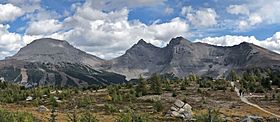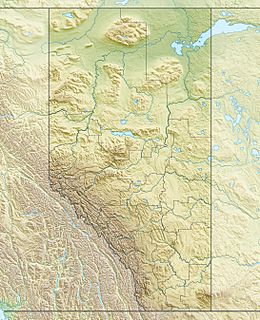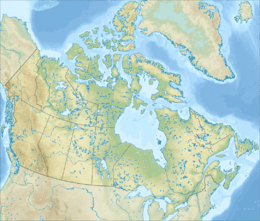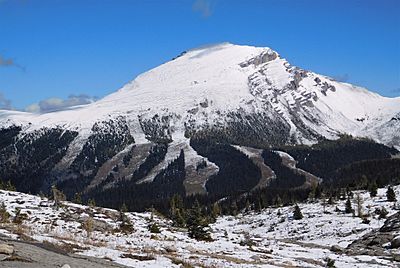Eagle Mountain (Alberta) facts for kids
Quick facts for kids Eagle Mountain |
|
|---|---|

Eagle Mountain in February 2011
|
|
| Highest point | |
| Elevation | 2,836 m (9,304 ft) |
| Prominence | 321 m (1,053 ft) |
| Listing | Mountains of Alberta |
| Geography | |
| Location | Banff National Park Alberta, Canada |
| Parent range | Canadian Rockies |
| Topo map | NTS 82O/04 |
| Climbing | |
| Easiest route | Hiking |

Eagle Mountain is a tall mountain in Banff National Park, Alberta, Canada. It stands 2,836 meters (9,304 feet) high. It is located just northeast of the Banff Sunshine ski resort. The mountain got its official name, Eagle Mountain, in 1958. Its closest taller neighbor is Mount Howard Douglas, about 1.5 kilometers (0.9 miles) away to the south-southeast.
One cool thing about Eagle Mountain is a natural hole in the rock called Goat's Eye. It's on the mountain's northeast side. This special window makes many people call it Goat's Eye Mountain. A long time ago, a person named George Simpson saw it. He wrote that it looked like a huge gateway to a giant's castle.
How Eagle Mountain Was Formed
Like other mountains in Banff National Park, Eagle Mountain is made of sedimentary rock. This type of rock forms when layers of sand, mud, and tiny bits of plants and animals settle at the bottom of ancient seas. Over millions of years, these layers get pressed together and turn into rock.
The rocks that make up Eagle Mountain were formed from the Precambrian to Jurassic periods. Later, during a time called the Laramide orogeny, huge forces pushed these rock layers. They were pushed east and even slid over younger rocks. This slow, powerful movement created the tall mountains we see today.
Weather and Climate
Eagle Mountain is in a subarctic climate zone. This means it has very cold, snowy winters. The summers are usually mild. Temperatures can drop below -20 °C ( -4 °F). With the wind, it can feel even colder, sometimes below -30 °C (-22 °F).
The snow and rain that fall on Eagle Mountain melt and flow down its sides. This water then drains into smaller streams. These streams eventually join the Bow River.




